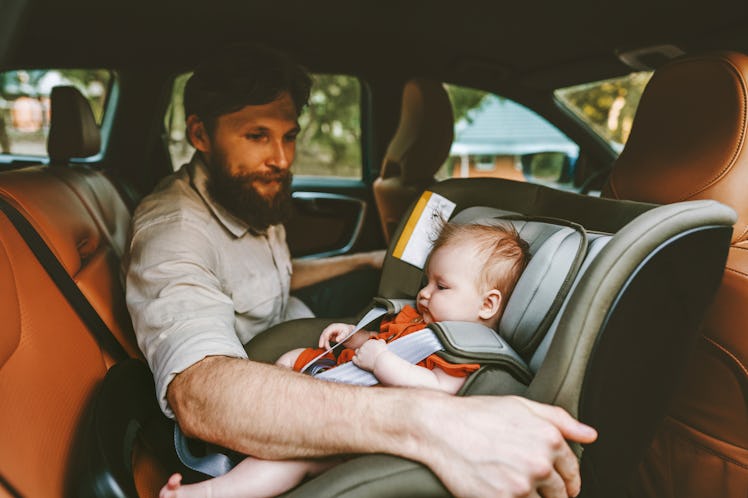The Reassuring Physics Of The Rear-Facing Car Seat
A 20-pound toddler traveling at 30 mph will require 600 pounds of restraining force to keep them in place.

How long should a child stay in a rear-facing seat? As long as possible — at least until the age of 2. Actually, as long as they fit the manufacturer’s height and weight specs, they should be in a rear-facing toddler car seat longer. Why? The American Academy of Pediatrics makes this recommendation based on a large body of research that shows that small children are much safer riding backward. Why not get a forward-facing car seat to celebrate a second birthday? The answer becomes clear when you understand the physics of car crashes.
Why A Rear-Facing Car Seat Is Safer
When it comes to fatal collisions, only about 7% of them happen at the back of the car. However, 60% to 80% of these crashes happen at the front or side of the vehicle. In a front-end collision, the driver snaps forward toward the point of impact (and is hopefully restrained by a seatbelt), while a rear-facing child falls backward (right into the car seat).
Since most crashes occur this way, keeping your kid in a rear-facing car seat stacks the deck in your favor. Odds are that when a serious crash occurs, your rear-facing child won’t snap forward into a harness and will instead experience crash forces that are about equally diffused along the car seat. This helps keep the neck and spine just where we want them (more on that later).
Why is it so important for the crash forces to be evenly distributed into the seat, rather than unevenly across a harness? Because every crash actually involves three collisions: the vehicle striking an object, the body of the occupant striking a harness, and the occupant’s internal organs striking the inside of the body.
In a front-end collision, the child is already seated (and therefore isn’t traveling into the car seat so much as being pushed further into it), so the second and third collisions occur more or less at the same time, reducing the odds of organ damage.
These forces, by the way, aren’t trivial. A 20-pound toddler traveling at 30 mph will require 600 pounds of restraining force to keep them in place. In the rare event of a serious rear collision, that means a rear-facing child snaps forward at 30 mph and feels 600 pounds pushing back. But in the more likely scenario of a front-end collision, those 600 pounds will push the child back into the seat.
Toddler Bones Need Rear-Facing Car Seats
Let’s say you buck the system and put your 1-year-old in a front-facing car seat. In the event of a front-end collision, we’re talking hundreds of pounds of stopping force (the exact figure is your child’s weight multiplied by the speed of the vehicle) exerted on the harness as your kid snaps forward. What does that mean for your child’s developing body?
First, it’s bad for the spinal cord. Small children have vertebrae that consist of small bits of cartilage, which will fuse into bone over time. Before age 2, there’s only a 50% chance that the vertebrae in the neck have finished converting from cartilage to bone. And in most cases, a child won’t sport a fully reinforced spine until age 6. Cartilage, unlike bone, allows the spinal cord to stretch up to two inches. It only takes a quarter of an inch of a stretch to cause paralysis or death.
When an adult jerks forward suddenly, their bony vertebrae usually prevents the spinal cord from stretching too much. But when a toddler experiences those same forces, the spinal cord will likely stretch beyond the point of no return. It doesn’t help that toddlers’ spines support heavy heads (up to 25% of the child’s total body weight). So, when your kid flies into a harness, that cranial cannonball forces the spine to stretch even more.
In other words, a harness protects your child’s torso, but does little to prevent their spinal cord from snapping in the event of a high-speed crash. The implications are counterintuitive: You want to position your car seat so that the harness is least likely to be what stops your child from flying toward the point of impact. Crash statistics tell us that the best way to accomplish that is by keeping your kid facing backward.
How Long Should My Kid Ride in a Rear-Facing Car Seat?
Ideally, you should keep your child in a rear-facing car seat until their spinal cord ossifies. But without a CT scan, you’re not going to know when that happens (and even at age 3, the odds barely approach 50%).
So when parents choose to keep their kids in rear-facing car seats past their second birthdays, they’re not overreacting. Most modern car seats can hold 3-year-olds quite comfortably. And, until those vertebrae turn to bone, having your kid ride backward might be the best advice. There are certainly no additional risks (as long as your child doesn’t exceed the manufacturer’s height and weight requirements) and a lot of potential gain.
“Rear-facing is not a choice to be made based on parenting style or opinion; it’s one based on scientific fact,” according to the nonprofit Car Seat for the Littles. “The more we know about physics and physiology, the better we’re able to protect our kids from severe injury.”
This article was originally published on